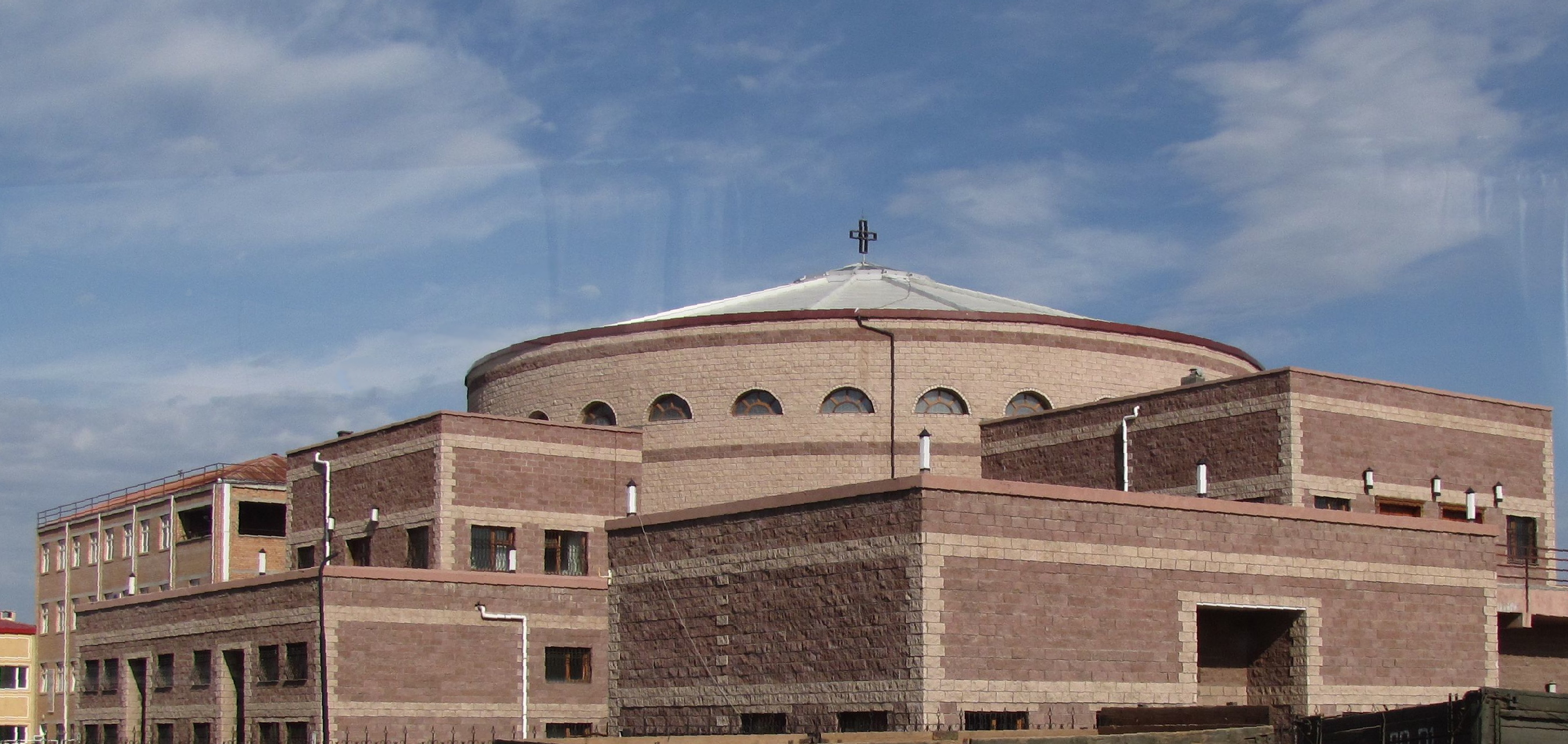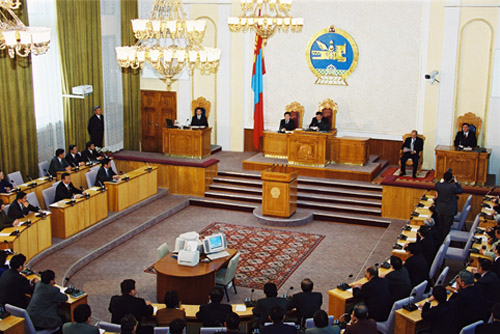|
Roman Catholicism In Mongolia
The Catholic Church in Mongolia is part of the worldwide Catholic Church, under the spiritual leadership of the Pope in Rome. There were approximately 1,300 Catholics in the country in 2017; they were served by three churches in the capital Ulaanbaatar plus churches in Darkhan, Arvaikheer, Erdenet and mission stations that may grow into churches. That population increased to 1,450 by 2023. Catholicism was first introduced in the 13th century during the Mongol empire, but died out with the demise of the Yuan Dynasty in 1368. New missionary activity only set in after the Second Opium War in the mid-19th century. A mission was founded for Outer Mongolia, giving Mongolia its first Catholic jurisdiction, but all work ceased within a year when a communist regime came to power. With the introduction of democracy in 1991, Catholic missionaries returned and rebuilt the church from scratch. As of 2016, there is an Apostolic Prefecture, a bishop, six churches, and diplomatic relations ... [...More Info...] [...Related Items...] OR: [Wikipedia] [Google] [Baidu] |
Giovanni Da Pian Del Carpine
Giovanni da Pian del Carpine, variously rendered in English as ''John of Pian de Carpine'', ''John of Plano Carpini'' or ''Joannes de Plano'' (c. 11851 August 1252), was a medieval Italian diplomat, archbishop and explorer and one of the first Europeans to enter the court of the Great Khan of the Mongol Empire. He is the author of the earliest important Western account of northern and Central Asia, Rus, and other regions of the Mongol dominion. He was the Primate of Serbia, based in Antivari, from 1247 to 1252. Life before the journey Giovanni appears to have been a native of Umbria, in central Italy. His surname was derived from Pian del Carpine (literally "Hornbeam Plain"), an area known later as Magione, between Perugia and Cortona. He was one of the companions and disciples of his near-contemporary and countryman Saint Francis of Assisi. Highly esteemed within the Franciscan order, Giovanni had a prominent role in the propagation of its teachings in northern Europe, holdi ... [...More Info...] [...Related Items...] OR: [Wikipedia] [Google] [Baidu] |
Politics Of Mongolia
Politics of Mongolia takes place in a framework of a semi-presidential multi-party representative democracy. Executive power is exercised by the Prime Minister, who is the head of government, and the Cabinet. The President is the head of state, but holds limited authority over the executive branch of the government, unlike full presidential republics like the United States. Legislative power is vested in parliament. The Judiciary is independent of the executive and the legislature. Socialist period and single party government Shortly after the Mongolian Revolution of 1921, Mongolia adopted a one-party socialist republican constitution modelled after the Soviet Union; only the communist party — the Mongolian People's Revolutionary Party (MPRP) — was officially permitted to function. Mongolian politics was closely monitored and directed by Kremlin. Any political opposition was brutally oppressed, and government officials who opposed the Soviet influence were murdered, execut ... [...More Info...] [...Related Items...] OR: [Wikipedia] [Google] [Baidu] |
Outer Mongolia
Outer Mongolia was the name of a territory in the Manchu-led Qing dynasty of China from 1691 to 1911. It corresponds to the modern-day independent state of Mongolia and the Russian republic of Tuva. The historical region gained ''de facto'' independence from Qing China during the Xinhai Revolution. While the administrative region of Outer Mongolia during the Qing dynasty only consisted of the four Khalkha aimags (Setsen Khan Aimag, Tüsheet Khan Aimag, Sain Noyon Khan Aimag, and Zasagt Khan Aimag), in the late Qing period "Outer Mongolia" was also used to refer to the combined Khalkha and Oirat regions, as well as the directly-ruled Tannu Uriankhai. The region was subsequently claimed by the Republic of China, which had acquired the legal right to inherit all Qing territories through the Imperial Edict of the Abdication of the Qing Emperor, as an integral part of the state. Most of Outer Mongolia, however, was under the ''de facto'' control of the Bogd Khanate, which was ... [...More Info...] [...Related Items...] OR: [Wikipedia] [Google] [Baidu] |
Inner Mongolia
Inner Mongolia, officially the Inner Mongolia Autonomous Region, is an autonomous region of the People's Republic of China. Its border includes most of the length of China's border with the country of Mongolia. Inner Mongolia also accounts for a small section of China's border with Russia (Zabaykalsky Krai). Its capital is Hohhot; other major cities include Baotou, Chifeng, Tongliao, and Ordos. The autonomous region was established in 1947, incorporating the areas of the former Republic of China provinces of Suiyuan, Chahar, Rehe, Liaobei, and Xing'an, along with the northern parts of Gansu and Ningxia. Its area makes it the third largest Chinese administrative subdivision, constituting approximately and 12% of China's total land area. Due to its long span from east to west, Inner Mongolia is geographically divided into eastern and western divisions. The eastern division is often included in Northeastern China (Dongbei) with major cities including Tongliao, Chifeng, Hai ... [...More Info...] [...Related Items...] OR: [Wikipedia] [Google] [Baidu] |
Catholic Encyclopedia
The ''Catholic Encyclopedia: An International Work of Reference on the Constitution, Doctrine, Discipline, and History of the Catholic Church'' (also referred to as the ''Old Catholic Encyclopedia'' and the ''Original Catholic Encyclopedia'') is an English-language encyclopedia published in the United States and designed to serve the Catholic Church. The first volume appeared in March 1907 and the last three volumes appeared in 1912, followed by a master index volume in 1914 and later supplementary volumes. It was designed "to give its readers full and authoritative information on the entire cycle of Catholic interests, action and doctrine". The ''Catholic Encyclopedia'' was published by the Robert Appleton Company (RAC), a publishing company incorporated at New York in February 1905 for the express purpose of publishing the encyclopedia. The five members of the encyclopedia's Editorial Board also served as the directors of the company. In 1912 the company's name was changed to ... [...More Info...] [...Related Items...] OR: [Wikipedia] [Google] [Baidu] |
Beijing
} Beijing ( ; ; ), alternatively romanized as Peking ( ), is the capital of the People's Republic of China. It is the center of power and development of the country. Beijing is the world's most populous national capital city, with over 21 million residents. It has an administrative area of , the third in the country after Guangzhou and Shanghai. It is located in Northern China, and is governed as a municipality under the direct administration of the State Council with 16 urban, suburban, and rural districts.Figures based on 2006 statistics published in 2007 National Statistical Yearbook of China and available online at archive. Retrieved 21 April 2009. Beijing is mostly surrounded by Hebei Province with the exception of neighboring Tianjin to the southeast; together, the three divisions form the Jingjinji megalopolis and the national capital region of China. Beijing is a global city and one of the world's leading centres for culture, diplomacy, politics, finance, busi ... [...More Info...] [...Related Items...] OR: [Wikipedia] [Google] [Baidu] |
Psalms
The Book of Psalms ( or ; he, תְּהִלִּים, , lit. "praises"), also known as the Psalms, or the Psalter, is the first book of the ("Writings"), the third section of the Tanakh, and a book of the Old Testament. The title is derived from the Greek translation, (), meaning "instrumental music" and, by extension, "the words accompanying the music". The book is an anthology of individual Hebrew religious hymns, with 150 in the Jewish and Western Christian tradition and more in the Eastern Christian churches. Many are linked to the name of David, but modern mainstream scholarship rejects his authorship, instead attributing the composition of the psalms to various authors writing between the 9th and 5th centuries BC. In the Quran, the Arabic word ‘Zabur’ is used for the Psalms of David in the Hebrew Bible. Structure Benedictions The Book of Psalms is divided into five sections, each closing with a doxology (i.e., a benediction). These divisions were probably intro ... [...More Info...] [...Related Items...] OR: [Wikipedia] [Google] [Baidu] |
New Testament
The New Testament grc, Ἡ Καινὴ Διαθήκη, transl. ; la, Novum Testamentum. (NT) is the second division of the Christian biblical canon. It discusses the teachings and person of Jesus, as well as events in first-century Christianity. The New Testament's background, the first division of the Christian Bible, is called the Old Testament, which is based primarily upon the Hebrew Bible; together they are regarded as sacred scripture by Christians. The New Testament is a collection of Christian texts originally written in the Koine Greek language, at different times by various authors. While the Old Testament canon varies somewhat between different Christian denominations, the 27-book canon of the New Testament has been almost universally recognized within Christianity since at least Late Antiquity. Thus, in almost all Christian traditions today, the New Testament consists of 27 books: * 4 canonical gospels (Matthew, Mark, Luke, and John) * The Acts of the Apostl ... [...More Info...] [...Related Items...] OR: [Wikipedia] [Google] [Baidu] |
John Of Montecorvino
John of Montecorvino or Giovanni da Montecorvino in Italian (1247 – 1328) was an Italian Franciscan missionary, traveller and statesman, founder of the earliest Latin Catholic missions in India and China, and archbishop of Peking. He converted many people during his missionary work and established several churches in Yuan dynasty-held Beijing. John of Montecorvino wrote a letter intending to convert the Great Khan to Catholicism. He was a contemporary of Marco Polo. Biography John was born at Montecorvino Rovella, in what is now Campania, Italy. As a member of a Latin Catholic religious order which at that time was chiefly concerned with the conversion of non-Catholics, he was commissioned in 1272 by the Byzantine emperor Michael VIII Palaiologos to Pope Gregory X, to negotiate for the reunion of the 'Greek' (Orthodox) and Latin churches. Commissioned by the Holy See to preach Christianity in the Nearer and Middle East, especially to the Asiatic hordes then threatening the W ... [...More Info...] [...Related Items...] OR: [Wikipedia] [Google] [Baidu] |
Keraites
The Keraites (also ''Kerait, Kereit, Khereid''; ; ) were one of the five dominant Mongol or Turkic tribal confederations (khanates) in the Altai-Sayan region during the 12th century. They had converted to the Church of the East (Nestorianism) in the early 11th century and are one of the possible sources of the European Prester John legend. Their original territory was expansive, corresponding to much of what is now Mongolia. Vasily Bartold (1913) located them along the upper Onon and Kherlen rivers and along the Tuul river. They were defeated by Genghis Khan in 1203 and became influential in the rise of the Mongol Empire, and were gradually absorbed into the succeeding Turco-Mongol khanates during the 13th century. Name In modern Mongolian, the confederation is spelled , (''Khereid''). In English, the name is primarily adopted as ''Keraites'', alternatively ''Kerait'', or ''Kereyit'', in some earlier texts also as Karait or Karaites."History of the voyages and discoveries ma ... [...More Info...] [...Related Items...] OR: [Wikipedia] [Google] [Baidu] |




.jpeg/1200px-Siège_de_Beijing_(1213-1214).jpeg)



